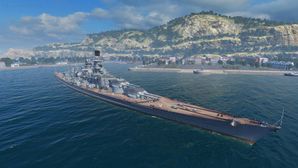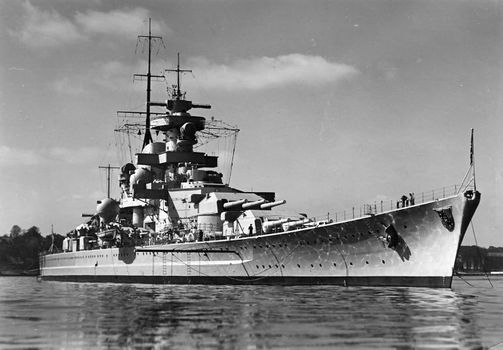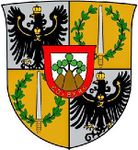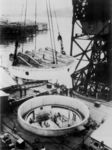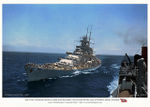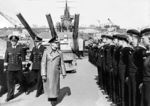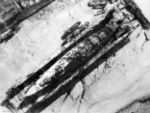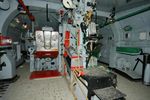Gneisenau
| Revision as of 14:00, 7 August 2018 updated design history | Revision as of 19:08, 7 August 2018 | |||
| Line 194: | Line 194: | |||
| ====Design==== | ====Design==== | |||
| ? | With the Deutschland-class the Kriegsmarine | + | With the commissioning of the last ''[[Ship:Admiral Graf Spee|Deutschland]]''-class vessel in 1936, the Kriegsmarine found itself in possession of warships that could outrun almost every ship that outgunned them, while being able to outgun almost every ship that could outrun them. The few exceptions to this were the British battlecruisers HMS ''Renown'', HMS ''Repulse'', and HMS ''Hood'', and the Japanese battleships of the ''[[Kongo]]'' class. The entry of ''Deutschland'' and her sister ships into service led the French begin designing a new class of battlecruisers — the ''[[Dunkerque]]'' class — which would be larger, stronger, and faster. | |
| ? | + | Having learned the intended operational specifications of ''Dunkerque'' and her sisters, German designers began development on improved versions of the ''Deutschland''-class, known as ''Panzerschiff D'' and ''Panzerschiff E''. Shortly after, however, the French laid down ''Strasbourg'', which was a more heavily-armored ''Dunkerque'' and would again outclass the nascent German designs. The Kriegsmarine responded by designing an even more powerful ship, this time with a third turret — to help overcome the difference in firepower between the two classes — a tougher armor scheme, and a stronger propulsion to allow high speeds. | ||
| ? | This step | + | This step was — strictly speaking — not entirely legal. The Treaty of Versailles forbade Germany from possessing any warship in excess of 10,000 tons displacement. With the new class being designed for a displacement in excess of 30,000 tons, they were in clear violation of their treaty obligations. Subsequently, Hitler reached out to Great Britain and initiated negotiations of a new Anglo-German Naval Treaty, which partially legitimized the construction of the new ships. Whether the treaty fully covered the legitimacy of the new ships remains topic of discussion even today. | |
| ? | The armament of these ships consisted of three triple turrets with 283mm guns, the same caliber as those found on the ''Deutschland'' class. However, these guns were modified to increase their performance | + | The armament of these ships consisted of three triple turrets with 283mm guns, the same caliber as those found on the ''Deutschland'' class. However, these guns were modified to increase their performance: the barrel was lengthened, and the weight of the shell increased. Additionally, the reloading and hoist system saw an improvement to allow a faster rate of fire, with reloads of 17 seconds being achieved during trials. Despite these improvements, German command knew that the 283mm guns were not competitive against larger surface units and planned early on to replace these guns with more powerful 380m twin turrets (the same as would later be mounted on the ''[[Bismarck]]'' class). One of the reasons to not install the turrets from the get-go was to not provoke the ire of their British neighbors, as negotiations with them were ongoing. | |
| ? | The | + | The secondary armament was a mixed load out of twelve 150mm guns, mounted in four twin and four single mountings, and a dual purpose battery of seven twin 105mm guns. In 1942 — following the usage of these ships as merchant raiders — both ''[[Scharnhorst]]'' and ''Gneisenau'' received two triple torpedo launchers that had been removed from light cruisers ''[[Nürnberg]]'' and ''Leipzig''. The mid-range anti aircraft armament consisted of eight twin 37mm ''Flakzwilling 30'', which were designed as a weapon against medium bombers; against mono planes, however, these guns would have limited effectiveness. Short range AA was provided by a steadily increasing number of 20mm guns in both single and quad mountings. | |
| ? | The propulsion was | + | The propulsion was upgraded from the ''Deutschland''s. Unlike the diesel propulsion of their immediate predecessors, the ''Scharnhorst'' class went back to traditional steam propulsion, able to crank out 125,000 shaft horsepower across three shafts; output could be pushed up to over 160,000 in times of great need. This gave the ''Scharnhorst'' class a design speed of 31 knots, with the highest noted speed being above 33 knots. A stern catapult would allow them to operate seaplanes for the purposes of scouting. | |
| ? | The protection of the ''Scharnhorst | + | The protection of the ''Scharnhorst'' class was drastically improved. The main armor belt was 350mm thick, and behind it followed a 105-110mm strong turtleback, which would deflect shells away from the vitals at short combat ranges. The horizontal protection consisted of a 50mm strong main deck, and the vital areas had an additional 80-95mm strong armored deck. | |
| ? | During their service these ships saw several modifications. The most important ones were the addition of an Atlantic bow in 1939 to improve the seaworthiness, the removal of the optical rangefinders of the A-turret in 1941 due to the lenses being constantly coated with water, the aforementioned addition of triple | + | During their service these ships saw several modifications. The most important ones were the addition of an Atlantic bow in 1939 to improve the seaworthiness, the removal of the optical rangefinders of the A-turret in 1941 due to the lenses being constantly coated with water, the aforementioned addition of triple-tube torpedo launchers in 1942, and the continual addition of radar and sensory equipment for the purpose of detecting and engaging opposing vessels. | |
| ====Service==== | ====Service==== | |||
Revision as of 19:08, 7 August 2018
| 380 mm/52 SK C/34 on a Drh LC/34 mount3 х 2 pcs. |
| Rate of Fire2.31 shots/min. |
| Reload Time26 sec. |
| Rotation Speed5 deg./sec. |
| 180 Degree Turn Time36 sec. |
| Firing Range17.77 km. |
| Maximum Dispersion255 m. |
| HE Shell380 mm Spr.Gr. L/4.6 |
| Maximum HE Shell Damage4,400 |
| Chance of Fire on Target Caused by HE Shell34 % |
| Initial HE Shell Velocity820 m./s. |
| HE Shell Weight800 kg. |
| AP Shell380 mm P.Spr.Gr. L/4.4 |
| Maximum AP Shell Damage11,600 |
| Initial AP Shell Velocity820 m./s. |
| AP Shell Weight800 kg. |
| 105 mm/65 SK C/33 on a Dop. L. C/31 mount7 х 2 pcs. |
| Firing Range6.3 km. |
| Rate of Fire17.91 shots/min. |
| Reload Time3.35 sec. |
| HE Shell105 mm Spr.Gr. Kz. |
| Maximum HE Shell Damage1,200 |
| Initial HE Shell Velocity900 m./s. |
| Chance of Fire on Target Caused by HE Shell5 % |
| 150 mm/55 SK C/28 on a Dop. L. C/34 mount4 х 2 pcs. |
| Firing Range6.3 km. |
| Rate of Fire8 shots/min. |
| Reload Time7.5 sec. |
| HE Shell150 mm Spr.Gr. L/4.5 |
| Maximum HE Shell Damage1,700 |
| Initial HE Shell Velocity875 m./s. |
| Chance of Fire on Target Caused by HE Shell8 % |
| 150 mm/55 SK C/28 on an MPL/35 mount4 х 1 pcs. |
| Firing Range6.3 km. |
| Rate of Fire8 shots/min. |
| Reload Time7.5 sec. |
| HE Shell150 mm Spr.Gr. L/4.5 |
| Maximum HE Shell Damage1,700 |
| Initial HE Shell Velocity875 m./s. |
| Chance of Fire on Target Caused by HE Shell8 % |
| 533 mm Drilling2 х 3 pcs. |
| Rate of Fire0.88 shots/min. |
| Reload Time68 sec. |
| Rotation Speed25 deg./sec. |
| 180 Degree Turn Time7.2 sec. |
| TorpedoG7a T1 |
| Maximum Damage13,700 |
| Torpedo Speed64 knot |
| Torpedo Range6 km. |
| 105 mm/65 SK C/33 on a Dop. L. C/31 mount7 х 2 pcs. |
| . . . Average Damage per Second116.2 |
| . . . Firing Range4.5 km. |
| 20 mm/65 C/38 on a Flak 35 Vierling L/38 mount7 х 4 pcs. |
| . . . Average Damage per Second42 |
| . . . Firing Range2.01 km. |
| 20 mm/65 C/38 on a twin mount14 х 2 pcs. |
| . . . Average Damage per Second58.8 |
| . . . Firing Range2.01 km. |
| 37 mm/83 SK C/30 on a Dopp LC/30 mount8 х 2 pcs. |
| . . . Average Damage per Second20.8 |
| . . . Firing Range3.51 km. |
| Maximum Speed28.8 knot |
| Turning Circle Radius830 m. |
| Rudder Shift Time20.6 sec. |
| Surface Detectability Range15.19 km. |
| Air Detectability Range10.39 km. |
Gneisenau — German Tier VII battleship.
A very high-speed battleship that was close to the battle cruiser type. Under the re-armament project, she was equipped with 380 mm guns that enabled her to fight off larger contemporary ships. Among her drawbacks were the small number of main guns and weak horizontal armor.
Modules
 |
Rate of Fire (shots/min) | Torpedo Tubes Reload Time (sec) | 180° Turn Time (sec) | Maximum Damage (HP) | Torpedo Speed (knot) | Torpedo Range (km) |
Research price (exp) |
Purchase price ( | |
|---|---|---|---|---|---|---|---|---|---|
| G7a T1 | 0.9 | 68 | 7.2 | 13,700 | 64 | 6 | 0 | 260,000 |
Compatible Upgrades
| Slot 1 |
|||||
|---|---|---|---|---|---|
| Slot 2 |
|||||
| Slot 3 |
|||||
| Slot 4 |
Player Opinion
Performance
Hailing as the first post-World War I battleship design in the German battleship line at Tier VII, Gneisenau dramatically shifts from the bulky, slow-to-react dreadnoughts that are more dangerous when they get close into a post-dreadnought battleship which can do many of the same things (to a certain degree) while remaining one of the most versatile battleships at her tier.
Playing Gneisenau is decidedly different from playing her American and Japanese counterparts at Tier VII (Colorado and Nagato, respectively). While Gneisenau may appear slender and lightly armored, don't be fooled: she is deceptively durable in the hands of a captain who knows how to handle her. Her 15-inch guns give her the capability of fighting on the same level as her peers, though she does have two fewer barrels. From a handling perspective, she's the fastest battleship out of the German line, and has no trouble keeping up with cruisers as needed.
Her speed is arguably Gneisenau’s greatest asset. It allows her to close the gap with enemy battleships and force them into close range where her main battery, secondary guns, and torpedoes can deliver the killing blow. While most battleships tend to join a battle line, Gneisenau can instead join up with fast cruisers and blitz the enemy by appearing quickly from an unexpected location. She is capable of operating solo, but extra caution is needed when doing so; her main battery dispersion is frequently frustrating, making long-range combat decidedly not her strong suit. Gneisenau is most comfortable at medium-to-close range — even point-blank range — where she can make every shell and torpedo count.
Gneisenau is unique in the game as the only regular tech tree battleship to have torpedoes available; the only other battleships with torpedo tubes are her premium sister Scharnhorst, the premium version of her successor, Tirpitz, and Japanese premiums Mutsu and Kii. Her rakish looks hide a brutal array of secondary batteries that unload at an impressive rate of fire, and are more than capable of shredding destroyers of equal and lower tiers (higher tier destroyers are likely to have concealment values that make closing with them suicidal).
Gneisenau — like Scharnhorst — is a ship that is equally at ease diving into a melee or holding back from one. Learning when to dive in and put her secondaries and torpedoes to work (and when not to) is half the fun of learning how to play her well.
Pros:
- Highly versatile battleship; her armament allows her to play as a typical battleship, while her speed lets her behave as a battlecruiser at need.
- Excellent 15-inch guns, same as those on Bismarck and Tirpitz.
- First-rate speed for a battleship (32 knots); the fastest battleship in the German battleship tree. With a Sierra Mike (
 ) signal, she is as fast as Tier IX's Iowa.
) signal, she is as fast as Tier IX's Iowa.
- Solid secondary battery guns, comparable to Japanese counterpart Nagato.
- Good range at her tier.
- Has one triple-tube torpedo launcher on each side.
- Outstanding armor belt combined with German turtleback armor scheme makes her deceptively durable.
- Reasonable concealment rating; with a captain that has Concealment Expert, her surface detection range goes down to an astounding 13.1km (comparable to the equal tier Japanese cruiser Myoko).
- Good anti-aircraft suite; when fully built for anti-air duties, she is deadly to enemy planes.
Cons:
- Short torpedo range of 6km.
- 15-inch guns have trouble with angled enemy battleships (use HE against the superstructure or choose a different target).
- Easily set on fire.
- She is nearly impossible to citadel, but will take a lot of full penetration damage.
- AB-X layout of dual mount turrets may feel lacking.
- Dispersion can be infuriating.
- Deck armor can potentially be penetrated by bigger guns.
- Rather bad turning radius.
Research
Optimal Configuration
Gneisenau doesn't mind brawling at close range; her commander skills and upgrades can be tailored to such tactics, or focused more on anti-aircraft defense to increase her survivability.
Upgrades
Gneisenau has access to four Upgrade Slots as a Tier VII ship. Gneisenau also has the option of building for Secondaries or AA.
- Slot 1: Main Armaments Modification 1
 to improve her main battery survival.
to improve her main battery survival.
- Slot 2: Damage Control System Modification 1
 to improve her overall survival in battle.
to improve her overall survival in battle.
- Slot 3: Aiming Systems Modification 1
 to improve her main battery accuracy, or AA Guns Modification 2 (
to improve her main battery accuracy, or AA Guns Modification 2 ( ) for an AA build, or Secondary Battery Modification 1 (
) for an AA build, or Secondary Battery Modification 1 ( ) for a secondary build.
) for a secondary build.
- Slot 4: Damage Control System Modification 2
 to further improve her overall survival. Steering Gears Modification 2
to further improve her overall survival. Steering Gears Modification 2  is also an option to improve her maneuverability.
is also an option to improve her maneuverability.
Even if choosing to focus on her secondary battery, Auxiliary Armaments Modification 1 ![]() is not recommended; improving the survivability of Gneisenau’s main battery with Main Armaments Mod 1 is still a better choice.
is not recommended; improving the survivability of Gneisenau’s main battery with Main Armaments Mod 1 is still a better choice.
Commander Skills
Secondary Battery Build: Priority Target or Preventative Maintenance at Level 1, Adrenaline Rush at Level 2, Superintendent at Level 3, Advanced Firing Training at Level 4. These skills increase Gneisenau’s survivability while buffing her secondary battery range. Subsequent points should be invested in Manual Fire for Secondary Armament and Basic Firing Training.
Anti-Aircraft Build: Priority Target or Preventative Maintenance at Level 1, Expert Marksman at Level 2, Superintendent at Level 3, Manual Fire Control for AA Armament at Level 4. Additional points should be put into Advanced Firing Training when available. Gneisenau is a deathtrap for enemy planes in this configuration, with an AA bubble that can extend out as far as 7.5km (with AA Gun Modification 2 in Upgrade Slot 2) and dispensing a punishing amount of damage from her 128mm dual-purpose guns.
| Recommended Commander Skills | ||||||||
|---|---|---|---|---|---|---|---|---|
| Cost (points) |
Endurance | Attack | Support | Versatility | ||||
| 1 |
★★ |
★★ |
★ |
|
|
|
★ |
|
| 2 |
★ |
★★ |
★★★ |
★ |
|
|
★ |
|
| 3 |
★★ |
★ |
★ |
|
★★ |
★★★ |
★ |
★★ |
| 4 |
★★★ |
★★ |
★ |
|
★★★ |
|
★ |
★★ |
| Key: ★★★ - Extremely Useful ★★ - Frequently Useful ★ - Occasionally Useful No stars - Meh Χ - Not recommended | ||||||||
Consumables
Gneisenau can equip the following consumables:
- Slot 1: Damage Control Party

- Slot 2: Repair Party

- Slot 3: Spotting Aircraft
 or Catapult Fighter
or Catapult Fighter 
Both Damage Control Party II (![]() ) and Repair Party II (
) and Repair Party II (![]() ) are recommended for the quicker cooldowns, especially for captains who have opted for the Secondary Battery Build.
) are recommended for the quicker cooldowns, especially for captains who have opted for the Secondary Battery Build.
Camouflage
Type 1, 2, or 5 camouflage can be equipped for credits; Types 2 or 5 are recommended at a minimum to reduce the accuracy of incoming shells.
Players who wish to spend doubloons can equip Gneisenau with Type 17 camouflage that lowers her detection radius, reduces the accuracy of incoming shells, reduces her repair costs, and increases the amount of experience she earns.
Signals
Players who have followed the Secondary Battery Build above will want to equip Mike Yankee Soxisix (![]() ) and India Delta (
) and India Delta (![]() ) signals in order to further boost the effectiveness of their secondaries and Repair Party
) signals in order to further boost the effectiveness of their secondaries and Repair Party ![]() consumable, respectively. Players following the Anti-Aircraft Build are encouraged to equip November Echo Setteseven (
consumable, respectively. Players following the Anti-Aircraft Build are encouraged to equip November Echo Setteseven (![]() ) for the bonus to AA gun damage.
) for the bonus to AA gun damage.
Recommended Signal Flags 
| |||||
|---|---|---|---|---|---|
| Combat | |||||

|
 ★ |
 ★★★ |
 ★ |

|

|
 ★ |
 ★★★ |

|
 ★★★ |
 ★ |
 ★★★ |

|

| ||||
Historical Info
Historical Gallery
